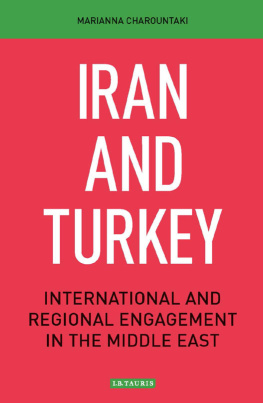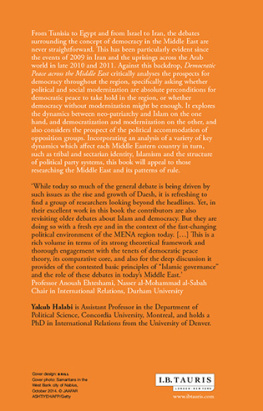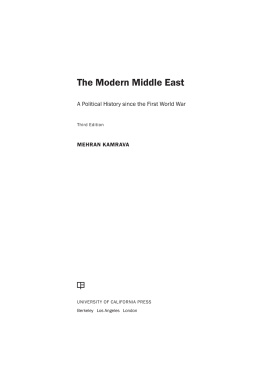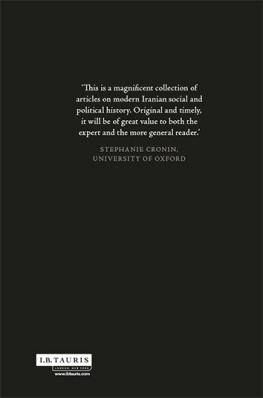First published in 1985
by Croom Helm
This edition first published in 2015 by Routledge
2 Park Square, Milton Park, Abingdon, Oxon, OX14 4RN
and by Routledge
711 Third Avenue, New York, NY 10017
Routledge is an imprint of the Taylor & Francis Group, an informa business
1985 Middle East Research Institute
The right of the Middle East Research Institute to be identified as author of this work has been asserted by him in accordance with sections 77 and 78 of the Copyright, Designs and Parents Act 1988.
All rights reserved. No part of this book may be reprinted or reproduced or utilised in any form or by any electronic, mechanical, or other means, now known or hereafter invented, including photocopying and recording, or in any information storage or retrieval system, without permission in writing from the publishers.
Publisher's Note
The publisher has gone to great lengths to ensure the quality of this reprint but points out that some imperfections in the original copies may be apparent.
Disclaimer
The publisher has made every effort to trace copyright holders and welcomes correspondence from those they have been unable to contact.
A Library of Congress record exists under LC control number: 85004165
ISBN 13: 978-1-138-90213-8 (hbk)
ISBN 13: 978-1-315-69753-6 (ebk)
1985 Middle East Research Institute
Croom Helm Ltd, Provident House, Burrell Row,
Beckenham, Kent BR3 1AT
Croom Helm Australia Pty Ltd, First Floor,
139 King Street, Sydney, NSW 2001, Australia
British Library Cataloguing in Publication Data
Iran. (MERI report)
1. Iran
I. MERI II. Series
955'.054 DS254.5
ISBN 0-7099-3550-1
Croom Helm, 51 Washington Street, Dover,
New Hampshire 03820, USA
Library of Congress Cataloging in Publication Data applied for.
Printed and bound in Great Britain
Antony Rowe Ltd., Chippenham
With an area of approximately 1,647,668 sq km (1 sq km = 0.386 sq mi), Iran is located in Southwest Asia and is bordered on the north by Russia and the Caspian Sea, on the east by Afghanistan and Pakistan, on the south by the Persian Gulf and the Gulf of Oman, and on the west by Iraq and Turkey. Much of Iran consists of a barren and largely uninhabited plateau of 300 to 450 m (1 . 0 m = 3.28 feet) in height, which is ringed on almost every side by mountainous terrain of various altitudes and extent.
Iran's climate is diversified. It is characterized by wide ranges in precipitation and in temperature; the latter varies from -27 C in the winter to 55 C in the summer (-18 to 132 F). Frequent strong winds intensify temperature contrasts. Iran is mostly arid except in Azerbaijan to the northwest and along the Caspian Sea coast which receives considerable rainfall.
The estimated population of Iran, according to the last official census of 1976, was 33,591,875. According to U.N. estimates, the 1982 population is 40.2 million and the annual rate of population growth is 2.6 percent. In 1976, 51.6 percent of the population was male. For the period 1975-80, the birth rate was 44.4 per 1,000, and the death rate was 13.6 per 1,000 .
The average density of the population is about 22 persons pet sq km; its distribution is largely influenced by climate and geography. The majority live in the north and northwestern regions, and about 70 percent of the country is virtually uninhabited. For years there has been a heavy migration of the popluation from rural to urban areas. The urban component of the population has been estimated at 44 percent and is growing steadily. About 60 percent of the people are Persians, with the rest of the population composed of such communities as Kurds, Baluchis, Turkomans, Azerbaijanis, Arabs, and others. Major languages spoken are Persian, various Turkic languages, Kurdish and Arabic.
The religious composition of the country is 93 percent Shii Muslim, 5 percent Sunni Muslim, and 2 percent Zoroastrian, Jew, Christian, and Bahai. There were about 100,000 foreigners (including 47,000 Americans) in Iran before the February, 1979 revolution, but that number has decreased considerably since then.
Rainfall satisfies about 10 percent of Iran's water needs and occurs mostly in the north and northwestern areas. In the central plateau and further south rainfall seldom exceeds 10 to 13 mm per year (1 mm = 0.039 inch). Because water is so scarce, all water resources were nationalized in 1967, when the Ministry of Water and Power was established. Agriculture depends to a great extent upon irrigation from man-made underground water channels (qanat), artesian wells, and rivers. Although Iran has a number of rivers which are used for irrigation and power purposes, only the Karun River is navigable. Iran supplies itself with fish from the Caspian Sea and the Persian Gulf. More than 50 percent of the land is desert, wasteland, or barren mountain range with no agricultural value; 11 percent is forested; 8.7 percent is used for grazing or pasture land; and about 1.5 percent consists of cities, villages, industrial centers and related areas. The remainder is made up of land that is either used for cultivation or could be used if adequate irrigation were supplied. By 1977 much of the land held by traditionally powerful land owners had been purchased by the government and resold to peasant farmers.
Iran has proven oil reserves, assuming secondary recovery, of 88 billion barrels and gas reserves of 400 trillion cubic feet. While Iran produced about 5.5 - 6 mbd of oil prior to the 1978-1979 unrest, oil production has dropped drastically since the February, 1979 revolution and its aftermath. In January 1980 oil production was at 2.34 mbd. In January 1982 total oil production was at 1.5 mbd, 1 mbd of which was being exported. By the first half of 1984, oil production had risen back to an average of 2.19 mbd. Production of natural gas has fallen in recent years; it stood at 15,700 million cubic meters in 1981-82 (compared with 41,700 million cubic meters in 1979-80).
Iran has substantial mineral deposits, e.g., copper, iron ore, copper lead, manganese, coal, sulphur and chromite, but these are still largely undeveloped. Iran is the world's largest producer of turquoise and fifth largest producer of zinc. Some chromite, lead, and rock sulfur are also exported.








